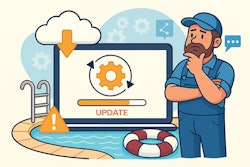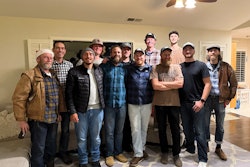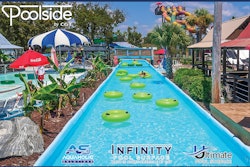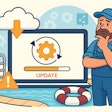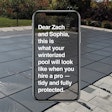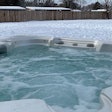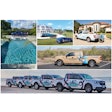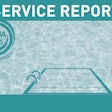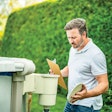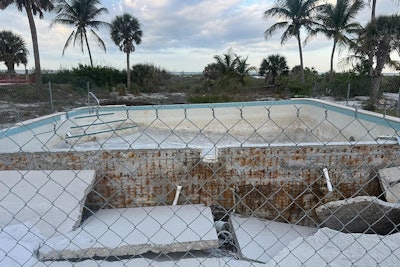
Ravaged. Desolate. Broken. Haunting. Abandoned.
These words describe the areas where pool service has been permanently altered by catastrophic weather events.
It’s tough to describe, as it’s an entirely different world now. Pool professionals in these regions are playing an entirely new game, writing the rules as they go. They’re creating protocols on the fly, but they can’t get too attached to any method because everything could change again tomorrow.
While the storms might seem like history, their ripple effects are still shaking up communities and businesses months after the devastation. This article isn’t a retrospective — it’s an ongoing account of how pool service professionals are navigating a new normal filled with uncertainty, resilience and constant innovation.
Hurricane Helene slammed into Florida on September 26, 2024, with winds reaching 140 miles per hour. The Category 4 storm didn’t just pass through — it obliterated everything in its path. Then, just two weeks later, Hurricane Milton, a Category 3, made landfall, spawning an EF-1 tornado in Cocoa Beach. The destruction was catastrophic.
Months later, the damage is still visible. For Vincent Milotta, every day is a reminder that standard pool treatment methods just don’t work here anymore.
Crystal River, Fla., was hit with more brutality than Milotta had ever anticipated. Pools became flooded graves of marine life, filled with sea water, homes were destroyed, and lives were turned upside down. It wasn’t just another storm — it marked the end of an era. Vincent, a veteran in the pool service industry, thought he’d seen it all. But this? This was something else entirely, a new nightmare.
Milotta is CEO and president of Crystal River Pools, a pool service and construction company. Before the storm, his work was routine maintenance. After Helene? There’s nothing routine left. Pools now contain salt levels soaring to 9,000 ppm — absurd by any standard. Insurance payouts are low, groundwater levels are too high, and many clients can’t afford to drain, refill and repeat the replacement of water, it’s unrealistic.
After several weeks or months of holding Gulf water, plaster has become saline-saturated. To bring salinity back down and maintain a level going forward of anywhere below brackish, pools need repeated drain-and-fill cycles to ‘flush’.
“For the pools we can’t drain due to high groundwater levels, I’m out there day after day, diluting the saltwater like a madman — adding fresh water, little by little,” says Milotta.
Saltwater’s just one issue. Phosphate and chlorine levels have surged to extreme highs, too. Fuhgeddaboudit! Stabilizing is practically impossible. Where pools used to hold a good FAC ppm for days, now they’re lucky to keep stable for more than a few hours. On top of the phosphates, salt, minerals and sundry sea shvitz, the seawater has a concentration of .00020 mol/L of bromide ions. This adds another layer to the problem.
During the remediation process, we deal with an entire community of bromine-treated pools — even though we’ve only added chlorine. The chlorine demand is through the roof. When bromide irons (Br -) in water encounter chlorine, they are oxidized to form bromine (Br₂). This reaction consumes chlorine, further increasing the chlorine demand.
“It takes weeks to get phosphate levels under control,” says Milotta. “I’m out there two or three times a week just to keep up. It feels like plugging a dam with chewing gum.”
 Vincent Milotta and his team at Crystal River Pools were recognized as "Hurricane Heroes" — a testament to their resilience and dedication in the face of unrelenting disaster recovery.
Vincent Milotta and his team at Crystal River Pools were recognized as "Hurricane Heroes" — a testament to their resilience and dedication in the face of unrelenting disaster recovery.
With elevated phosphorus levels in nearshore sediments — especially at the mouths of estuaries, which are common along the Florida coast — total concentrations in parts of the Gulf range from 1.8 to 45.9 μmol/g, with an average of 11.3 μmol/g. If my math is correct, that translates to an average of about 351 ppm, although phosphate isn’t typically measured in parts per million. Converted to parts per billion, that’s 351,000 ppb. Uffa!
And that’s just from the Gulf, not including everything else dragged inland by the storm and floods. Keep in mind, Florida is home to numerous phosphate mines, so this isn’t just runoff, it’s legacy sediment from decades of extraction.
While Milotta’s regular clients are finally manageable (aside from salt levels creeping upward due to plaster saturated with shtus and saline), his team is overwhelmed with new requests. Some will become loyal customers, but many are one-offs. Yet, he turns no one away.
“When you’re part of a community, you do everything you can,” he says.
Scraping barnacles off pool plaster wasn’t part of the job description. But now? Milotta is knee-deep in muck with a putty knife in hand, still dealing with fish and crabs — everything you’d find in a biology class has washed into pools. I touched on this in my December article for AQUA titled “Shiver Me Timbers,” discussing pool barnacles in the aftermath of storm surges.
But the real challenge isn’t just the water chemistry. The equipment is a disaster. Some pumps survive the saltwater, but most don’t. The few that do are the exception, not the rule. “I’ve swapped out pumps, filters, and heaters for most of my clients. And with insurance payouts slow, it isn’t easy,” explains Milotta. “My regulars get my attention first, but I’m getting daily calls for storm-surge-‘claimed’ pools.”
Now, we’re already back in Hurricane season, which meteorologists predict will be the worst one yet — and Milotta has been preparing since January. He’s raising equipment pads, for example, some with concrete blocks, others with wooden or composite decking. His goal? To keep the equipment above water. “From now on, every equipment pad I install will be higher than the worst flood levels. Crystal River Pools installs filters, not submarines.”
He’s also rethinking how he approaches saltwater pools. “If the pool is filled with saltwater anyway, and storms are a constant threat, we might as well work with it. We switch to salt systems where we can. If we can only get the salt levels down to 3,000 or 4,000 ppm, we’re set. For others, I don’t push it — we just help them hang on.”
It’s been a long grind, but Milotta isn’t just about fixing pools; he’s helping people return to normal. Some clients can’t afford much, so he offers discounts and free cleanups. “Sometimes, you just gotta do what you gotta do to help people get back on their feet,” he says.
Six months later, the storm’s aftermath is still present. Pools remain unpredictable. Even with extra salt bags and higher chlorine levels, Crystal River Pools finds that new problems arise daily. The new normal is just as unpredictable as the weather itself. But now, with hurricane season looming again, Milotta has a plan and a better understanding of what a worst-case scenario truly looks like.
Meanwhile, Jeff Murphy of Murphy’s Pool Solutions faces his relentless battle down the coast in Fort Myers Beach. The storm pushed the Gulf into his route, flooding everything by 15 feet. The pools Murphy once serviced — pristine and perfect — were submerged in saltwater. They’re a stark reminder of nature’s destructive power. Jeff has been in the business for years, but now, every pool he services is a different beast. Each one needs to be vacuumed every time, twice. Salt, debris — it’s a constant grind.

Filters that used to last six months now last only three, sometimes less. Salt levels in some pools are as high as 32,000 ppm. And Jeff’s equipment? It’s wearing out fast. The tires on his route truck are only lasting a month or two. The bed of his truck is filled with sand and debris, almost like a beach. “F*** my life,” Murphy grumbles. Who could blame him? The work is never-ending, and the storm’s aftermath isn’t over. It’s here to stay.
His trusty vacuum system? Even that’s struggling with the debris overload because of microscopic junk. “It’s like the pools are fighting back,” says Murphy. “I stopped taking pictures a long time ago. Seeing pools like this isn’t an oddity anymore. It’s the norm.”
The storm surge also forced local municipalities to replace water mains, which meant more debris being flushed into pools. Pool pros like Murphy started getting complaints about staining. Stain removers help, but only temporarily, a Band-Aid solution. The debris returns, so he has to explain that the only real fix is to replace the water — again. The cycle feels endless: clean, replace, repeat.
“It’s just not enough anymore,” Murphy admits. “People’s lives were wrecked. You work with them, but the storm keeps haunting you no matter how much you clean, replace or fix.”
The emotional toll is hard to shake. The work is more intricate, systems break down faster, and those oncepeaceful pools have become symbols of a battle no one can win. Murphy’s committed for the long haul, but whether he’s gaining ground? Even he’s not sure.
With more storms predicted, the pool service industry has no choice but to adapt. It’s not just about repairing pools and replacing equipment anymore. Now, it’s about building strategies for survival. I’ve seen professionals like Milotta and Murphy develop new ways to prepare for disasters — adjusting to saltwater pools, raising equipment, and finding creative solutions to problems they never expected.
But it’s not just Florida. The storm’s impact stretches beyond the coast. Asheville, N.C., is still reeling. One service company lost an entire warehouse full of new equipment and spas. For them, the road to recovery is long. But what’s been truly inspiring is how the community has come together. Despite their challenges, local crews from places like Tennessee came in to help.
Still, there are complaints. Many believe that organizations like FEMA have been slow to respond and that community-driven support has been the only reason they’re making progress.
“We’ve had to rely on each other more than anything else,” Wendy Purser, a local consultant, tells me. “Without that, many businesses just wouldn’t have made it.”
Despite it all, some businesses are already being recognized for their resilience. In March 2025, Milotta and his company were honored as “Hurricane Heroes” by the city of Crystal River. It’s a well-earned recognition, but it’s clear the work isn’t over. The future is uncertain, and these pool professionals are fighting daily to adapt and stay afloat.

This article first appeared in the June 2025 issue of AQUA Magazine — the top resource for retailers, builders and service pros in the pool and spa industry. Subscriptions to the print magazine are free to all industry professionals. Click here to subscribe.


























